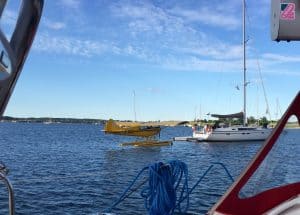We did visit the small island of Barsø, anchoring off the night before and spending much of the day walking ashore. Barsø is another agricultural island with several large farmsteads and perhaps a dozen other houses. It was very quiet – we were probably the only visitors. This tiny harbour had excellent free and open WiFi, which we could pick up out on our anchorage. If only UK harbours were so public spirited!
In the evening we sailed south to the start of the sound between the island of Als and the Jutland mainland and tucked into the inlet of Dyvig. This has a very narrow entrance but opens up into a kind of lagoon. The next day we sailed further south through the Als Sund until we came to the town of Sønderborg, where we moored on the town quay and spent some time ‘in town’ as a change from our time at anchor – sitting in a café and watching the world walk by.
On Saturday we sailed out from Sønderborg into the Sønderborg Bucht, a large area of sheltered water. Now this is not far from the Flensburg and Schlei fjords and a convenient weekend excursion for many German yachts and the water was filled with sails. It reminded us of the Solent on a fine summer’s weekend. We anchored, along with a dozen other yachts off the Kegnæs peninsular. Our neighbours had some friends ‘drop in’ by seaplane to stay over – making an unusual tender. On the Sunday almost all the yachts headed back home and the waters became spacious again. We sailed into the Flensburg Fjord and tucked up first in the Nybøl Nor lagoon and the next day headed into Flensburg itself.
Now this is not far from the Flensburg and Schlei fjords and a convenient weekend excursion for many German yachts and the water was filled with sails. It reminded us of the Solent on a fine summer’s weekend. We anchored, along with a dozen other yachts off the Kegnæs peninsular. Our neighbours had some friends ‘drop in’ by seaplane to stay over – making an unusual tender. On the Sunday almost all the yachts headed back home and the waters became spacious again. We sailed into the Flensburg Fjord and tucked up first in the Nybøl Nor lagoon and the next day headed into Flensburg itself.
 Flensburg lies spread across the valley at the head of the fjord and is an ancient trading port. The old city retains its medieval layout with dozens of alley ways and courtyards often lined with what were once warehouses, many still with their hoists to the upper floors and workshops below. It is a fascinating place and we explored it over two days.
Flensburg lies spread across the valley at the head of the fjord and is an ancient trading port. The old city retains its medieval layout with dozens of alley ways and courtyards often lined with what were once warehouses, many still with their hoists to the upper floors and workshops below. It is a fascinating place and we explored it over two days.
The channel in the Flensburger Fjord is the border between Germany and Denmark. The starboard hand marks are Danish and the port hand ones German. The city itself has been Danish and German at various times. Following a plebiscite organised by the League of Nations in 1920, some northern districts were ceded to Denmark but the main city voted to stay with Germany.
In the city, there is a sizeable Danish minority, which runs its own schools, churches and other institutions. There is a local language/dialect Petuh, which is a a mixture of German, Low German, Danish, and Southern Jutish. It is High German in vocabulary (with some Danish concepts and loan translations), but it has Danish and Low Saxon grammar and syntax. It is now on the verge of extinction although we heard the all-day greeting Moin used extensively.
We have timed our visit to Flensburg so we can pick up a hire car and leave Antipole for two nights while we travel back to the Netherlands – first to Ynskje’s mum Trees and then on to Amstelveen for the wedding of Ynskje’s nephew Raban and Kelly. It will be a significant family gathering.
That’s our news for now.
Ynskje & Tony
